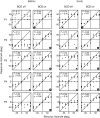Improved horizontal directional hearing in bone conduction device users with acquired unilateral conductive hearing loss
- PMID: 20838845
- PMCID: PMC3015026
- DOI: 10.1007/s10162-010-0235-2
Improved horizontal directional hearing in bone conduction device users with acquired unilateral conductive hearing loss
Abstract
We examined horizontal directional hearing in patients with acquired severe unilateral conductive hearing loss (UCHL). All patients (n = 12) had been fitted with a bone conduction device (BCD) to restore bilateral hearing. The patients were tested in the unaided (monaural) and aided (binaural) hearing condition. Five listeners without hearing loss were tested as a control group while listening with a monaural plug and earmuff, or with both ears (binaural). We randomly varied stimulus presentation levels to assess whether listeners relied on the acoustic head-shadow effect (HSE) for horizontal (azimuth) localization. Moreover, to prevent sound localization on the basis of monaural spectral shape cues from head and pinna, subjects were exposed to narrow band (1/3 octave) noises. We demonstrate that the BCD significantly improved sound localization in 8/12 of the UCHL patients. Interestingly, under monaural hearing (BCD off), we observed fairly good unaided azimuth localization performance in 4/12 of the patients. Our multiple regression analysis shows that all patients relied on the ambiguous HSE for localization. In contrast, acutely plugged control listeners did not employ the HSE. Our data confirm and further extend results of recent studies on the use of sound localization cues in chronic and acute monaural listening.
Figures






References
-
- Blauert J. Spatial hearing. The psychophysics of human sound localization. Cambridge: MIT; 1997.
-
- Colburn HS. Binaural interaction and localization with various hearing impairments. Scand Audiol Suppl. 1982;15:27–45. - PubMed
-
- Goossens HH, van Opstal AJ. Influence of head position on the spatial representation of acoustic targets. J Neurophysiol. 1999;81:2720–2736. - PubMed
Publication types
MeSH terms
LinkOut - more resources
Full Text Sources
Medical

